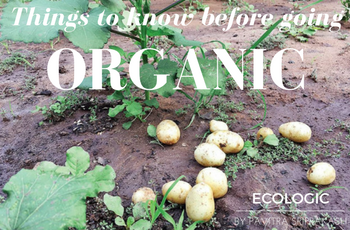18 Mar 2017, New Indian Express: ECOLOGIC- Pavitra Sriprakash, the Chief Designer and Director of Shilpa Architects writes about going organic.
PDF | Link to New Indian Express Site
Full Article:
Organic food, organic fabrics, organic Holi colors?! The market is abuzz with products fashionably advertised as organic – from daily consumables like shampoos and soaps to offbeat designer clothes! The word ‘Organic’ is repeated ad nauseam and some products slyly pass off as inherently good just because they are simply tagged so. Now, here is the dilemma when buying commodities: how much organic is too organic; because organic products usually cost more.
It seems people world over are leading robust lives and eating healthily; but they are unwittingly ingesting insecticides, fungicides, herbicides, rodenticides, molluscicides, nematicides, plant growth regulators among others. There is way too much chemicals in food chains than is good. These compounds, synthesized artificially to boost productivity in “modern scientific farms” are ALL toxic. Crop yields have increased dramatically but unscrupulous practices have left behind a lethal cocktail of dangerous compounds. They are an inseparable part of common lifestyles, food preferences and diets. Many studies link pesticides in foods with various ailments without doubt, from IQ loss to cancer! It is now an obvious no brainier to prefer nutritious and safe organic foods for long-term wellness.
Many plant-based foods are industrially produced with genetically modified technologies or retailed with high residual pesticides. Based on the 2015 Report of the Environmental Working Group (EWG), an ‘O-List’ (Organic Must Buy List!) was published. These are highly recommended edibles that should be bought “organic” even if they dent monthly food budgets. Here are some pointers that will make extra spend on organic alternates worthwhile at the grocers.
Fruits with thin skins like apples, peaches, pears, grapes and strawberries are all on the O-List. Research publications reveal that “99% of apples contain at least one residual pesticide … and 15 different types of pesticides are typically found on grapes.” When it comes to veggies, the “dirtiest” are potatoes and spinach. It seems definitely worthwhile to go organic on these household staples. Also on the veggie O-List are ladies finger, tomatoes, cucumber, corn, capsicum and most other leafy greens.
Dairy products too, like milk, cheese and yogurt rank high on the O-List. Certified organic dairy products are from cows and buffaloes reared entirely on organic feeds without antibiotics or growth hormones. Non-vegetarians must beware that conventional meat contains all these deadly chemicals in good measure. After all most cows, chicken, and other animals are reared with additives to spur meat production in commercial enterprises intent to maximize returns on investment.
It seems only fair to counter the O-list with a ‘Clean-List’ of foods where it is just fine and safe to buy “conventional,” such as bananas, which have a thick skin. Others include watermelon, pineapple, papaya, muskmelon, mangoes and kiwi. Vegetables like drumsticks, onions, cauliflower, cabbage (red/white or purple), brinjal, peas, pumpkin, gourds, mushrooms and sweet potatoes find mention here. Amongst the less common vegetables included in the Clean List are avocadoes and asparagus.
So there we have it folks: O-List vs Clean-List! Choose smartly and keep your wallet happy!



